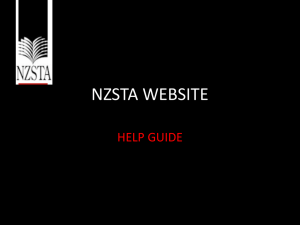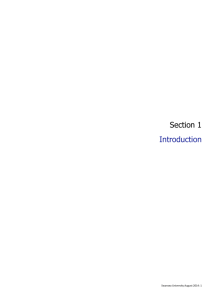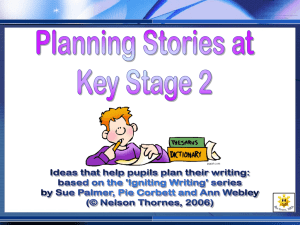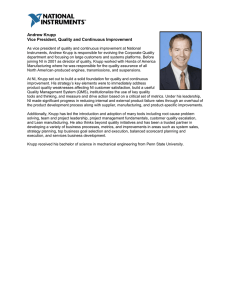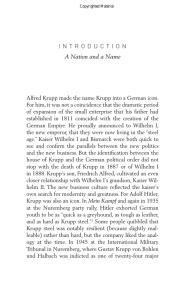Phase 1 Short Form Industrial Technologists' Toolkit For Technical
advertisement
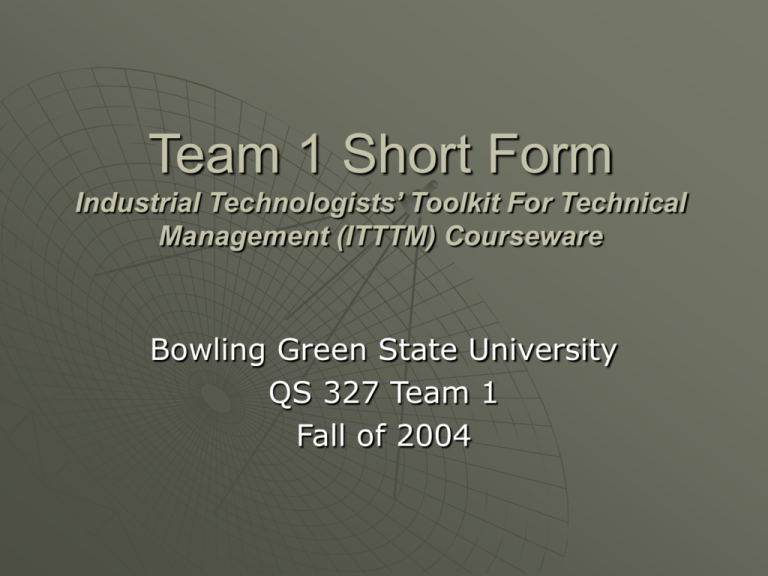
Team 1 Short Form Industrial Technologists’ Toolkit For Technical Management (ITTTM) Courseware Bowling Green State University QS 327 Team 1 Fall of 2004 Content Individuals Involved Project Outline Project Goals Purpose Problems/Solutions Theories/Methods Roles Team 1 is made up of 9 individuals, Justin Stokes, Rachel McCully, Jason Grubb, Spencer Krupp, Aaron Larmore, James Steger, Sam Wiley, Brook Wilson & Kyle Zimmerman Project Outline The goal of this project is the fine tuning of a manufacturing process using kaizen as well as other methods to fine tune a manufacturing process. To guide in this process is a Toolkit created by Dr. John Sinn. This toolkit allows information to be documented correctly throughout each step as well as tracking value added or lost by the changes made. Project Outline (cont.) Documentation must be correct and consistent throughout the project Project Goals The creation and fine tuning of a packet that can be used by a company (small-large) to aid in decision making and improvements. To help a company remain competitive in today’s manufacturing environment. The toolkit should be user friendly and show each necessary step and what is required of each step. Purpose The fine tuning of a process which, when used, will improve the value of any manufacturing environment The toolkit should be user friendly and show each necessary step and what is required of each step. Problems & Solutions There have been issues with communication of desired goals • This has occurred several times, what is required from each individual as well as what the final results should be Issues of non-value adding information as well as redundant tables have also created some problems • In early stages of Tool development, tables have been copied and this has led to of repetition. • This may have to do with confusion of what it is we are doing As the project progresses the team is grasping what is needed and what can be left out. • Several different views of what we are doing are now being used • These are leading to a more robust document Theories/Methods Using Blackboard as the centralized meeting area as well as information sharing center, we as a team have made great improvements to reach the point we are at here at the end of Phase I Un-required meetings have been attended by much of the team to further guide each other to the end of each tool Thread organization has lead to improved efficiency in document compiling Toolkits 19-24 Industrial Technologists’ Toolkit For Technical Management (ITTTM) Courseware Bowling Green State University QS 327 Team 1 Fall of 2004 Content Problems and Solutions Pros/Cons Phase 1 • Roles • Content and Issues Tool 19 Tool 20 Tool 21 Phase 1 Phase 2 • Goals • Roles • Content and Issues Tool 22 Tool 23 Tool 24 Phase 2 Problems & Solutions Many of the same problems are present in Phase 2, but not as much. There have been issues with communication of desired goals • There has been a good improvement from Phase 1 to Phase 2, but even a better improvement form Tool 22 to Tool 23. • The team has become more strict on deadlines and things are getting done. Issues of non-value adding information as well as redundant tables have also created some problems • There is still the issue of people coping others work. The only solution is to watch closely and evaluate according on the TPPMA. Final Overview/Phase II Pros and Cons of the Class Individual tool review Progression from start to finish Value added Technology Assessment Summation of Content Pros Weaknesses in team work were brought to attention quickly, allowing for necessary adjustments. Showed the importance of communication as a group and amongst individuals. Realization of the importance of correct and consistent documentation in today’s industry Cons Instruction was not always clear and concise Vagueness of direction led to great confusion throughout most of the class, also led to half-hearted effort. Specific and standard cases could have led to a more value adding final document Too much repetition in many of the tables, there are only so many ways to boil water no matter how many people try. Phase 1 Roles Team Leaders are Justin Stokes and Rachel McCully Researchers consist of Jason Grubb, Spencer Krupp, Aaron Larmore, James Steger, Sam Wiley, Brook Wilson & Kyle Zimmerman . Tool 19 This was a lot of guess work from all involved Many had no idea what was required from them Some definitions of terms that were to be later used were defined Gave an idea of what it was the would be later required for time input Tool 19 Content ISOQSAOPP: Distinguished the level of importance for certain priorities for each team member, set the beginning focus for improvement DSDC: established the parameters for communication throughout the course GOTA: Gave definitions for terms that would be used for the remainder of the course Tool 20 Issues Formatting was greatly improved Still issues of the what direction was to be taken Work load was still unevenly distributed Biggest confusion for most was still what the project was on and where to get information from Tool 20 Content GCA: Information on part cost, investment into the production, overhead costs, and the Return on Investment. Also established what was needed to break even and make a profit KCA: Current process time was calculated as well as the time goal and other factors that would maximize profit MAACE: Each individual section of production was looked at and the amount of cost for each section Tool 21 Issues Better understanding of where to go with the tables Repetition an increasing concern, due perhaps to unknown goals and process Formatting greatly improved from previous tools Tool 21 Content GCA: Update from the previous tool, consisted of the overall profit gain by switching to the new process TAMA: Calculated the TAKT time which could be later used to show weak points or bottle necks during the process SOPATA: Indicated whether there was room for improvement and just how much time would be gained by changing that step Phase I Issues Overall strong improvement in the short amount of time from Tool 19 to the completion of Phase I Work load for the majority of Phase I uneven Clarity on what is expected for a final result still a concern Phase I Content Established the overall time and investments into the process and what can be gained or lost by changing it Information was gathered for later use, such as time and money input at each juncture Phase 2 Goals To Work More Interpedently as a Group Push Team Members to Become Better Focused Continue to Improve Phase 2 Roles Team Leaders are Kyle Zimmerman and Rachel McCully Researchers consist of Jason Grubb, Spencer Krupp, Aaron Larmore, James Steger, Sam Wiley, Brook Wilson & Justin Stokes Tool 22 Content GBAPS: Compared the current process to another very similar process, showed weak and strong OCA: Breaks down the process into each individual step, the time involved, distance need to travel and many other details. Can be used to show weak points and bottle necking SOPATA: Graphical representation of any weak points during the manufacturing process Tool 23 Issues By far the best tool to date Formatting was much more in sync from team member to member Individual work and information provided much better Communication at this juncture was by far its best Participation a remaining concern however Tool 23 Content CEAS: Using tolerances and control limits this calculates the reliability and consistency of the process as well as how urgent changes need to be made FMEA: Potential failures are recorded as well as the potential number of failures, this can be used to indicate what issues needs to be addressed QFD: Ranks the importance of certain factors such as receipt of part on time and in spec for both the supplier and the customer and then takes averages of the table to indicate what should be addressed as the most important and so on Tool 24 Issues Best tool overall Formatting was the biggest issue Majority of those involved were understanding what was required Assignments were being turned in sooner Tool 24 Content GFAPS: Description of any necessary failsafing improvements, the purpose and hopeful result as well as who will be conducting them GSICPC: Auditing of the cleanliness and orderliness of the working environment and the frequency of the occurrence. Also a graphical representation of these items, will indicate who unorganized and unkempt an area is MTA: Sets and tracks a Preventative Maintenance program as well as the cost, time and frequency involved for each PM Phase II/Final Issue Group progression was very strong in the final three tools, participation steadily increased, work was being finished on time more often Contributions were much more value adding with information provided supporting any findings and ideas occurring more frequently Overall group improvement was great from the beginning of the semester to the end Perhaps a more specific project goal from the beginning rather than guessing for a majority of the semester for raw data and information could have led to a better experience for all involved Phase II/Final Content A start to finish document creation for an effective kaizen and general improvement process that can be used in almost any production facility in today’s manufacturing environment to remain competitive Useful for streamlining of a line for maximum profit, minimum cost and waste

![Service Coordination Toolkit Transition Planning Checklist [ DOC ]](http://s3.studylib.net/store/data/006933472_1-c85cecf2cfb8d9a7f8ddf8ceba8acaf8-300x300.png)

